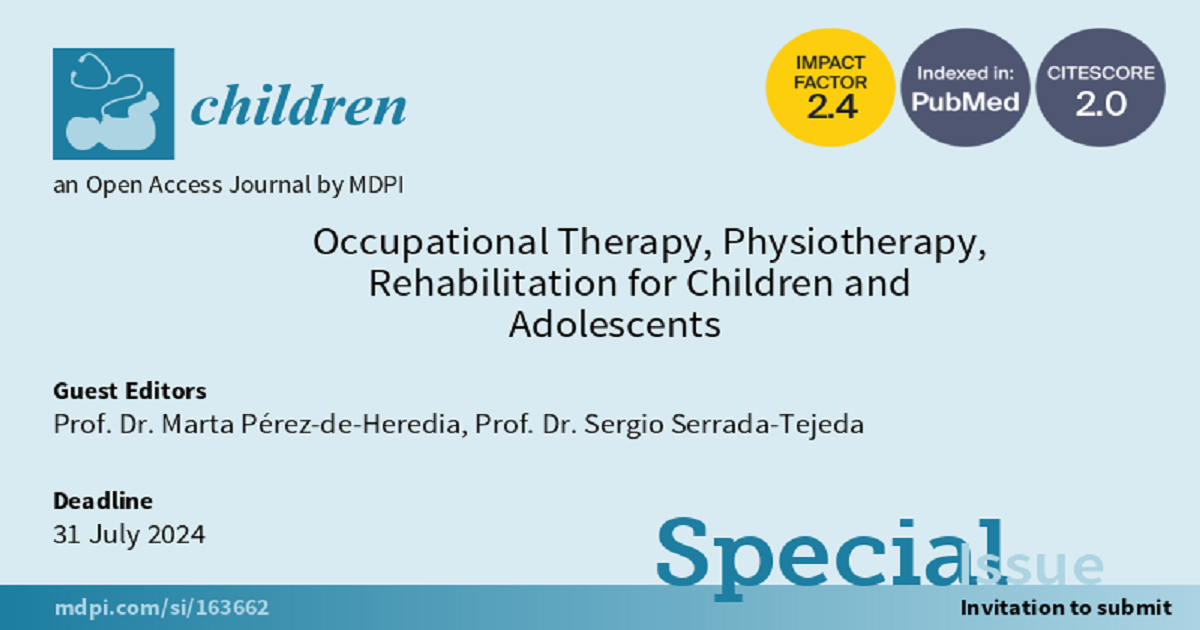Occupational Therapy, Physiotherapy, Rehabilitation for Children and Adolescents
A special issue of Children (ISSN 2227-9067).
Deadline for manuscript submissions: 30 September 2024 | Viewed by 7563

Special Issue Editors
Interests: occupational therapy; physiotherapy; rehabilitation
Interests: occupational therapy; physiotherapy; rehabilitation
Special Issue Information
Dear Colleagues,
Therapeutic interventions for children and young people with disabilities have evolved in recent years. This paradigm shift in intervention has been aimed at improving functionality and participation in relevant contexts for children and their families. Education and research are fundamental components for the development of appropriate assessment tools for evaluating and identifying relevant evidence in occupational therapy and physiotherapy to inform practice, education, and research. These are fundamental elements in addressing the challenges and needs of the intervention process in the rehabilitation of children and adolescents. The aim of this Special Issue is to provide a comprehensive and innovative overview of the evolution of clinical research regarding new developments in the assessment and intervention of children and adolescents with disabilities in occupational therapy and physiotherapy.
This issue especially seeks findings from empirical studies (quantitative, qualitative, or mixed methods), systematic reviews, or meta-analyses that can be used to inform occupational therapy and physical therapy practice, education, research, or policymaking decisions.
Prof. Dr. Marta Pérez-de-Heredia
Guest Editor
Prof. Dr. Sergio Serrada-Tejeda
Guest Editor Assistant
Manuscript Submission Information
Manuscripts should be submitted online at www.mdpi.com by registering and logging in to this website. Once you are registered, click here to go to the submission form. Manuscripts can be submitted until the deadline. All submissions that pass pre-check are peer-reviewed. Accepted papers will be published continuously in the journal (as soon as accepted) and will be listed together on the special issue website. Research articles, review articles as well as short communications are invited. For planned papers, a title and short abstract (about 100 words) can be sent to the Editorial Office for announcement on this website.
Submitted manuscripts should not have been published previously, nor be under consideration for publication elsewhere (except conference proceedings papers). All manuscripts are thoroughly refereed through a single-blind peer-review process. A guide for authors and other relevant information for submission of manuscripts is available on the Instructions for Authors page. Children is an international peer-reviewed open access monthly journal published by MDPI.
Please visit the Instructions for Authors page before submitting a manuscript. The Article Processing Charge (APC) for publication in this open access journal is 2400 CHF (Swiss Francs). Submitted papers should be well formatted and use good English. Authors may use MDPI's English editing service prior to publication or during author revisions.
Benefits of Publishing in a Special Issue
- Ease of navigation: Grouping papers by topic helps scholars navigate broad scope journals more efficiently.
- Greater discoverability: Special Issues support the reach and impact of scientific research. Articles in Special Issues are more discoverable and cited more frequently.
- Expansion of research network: Special Issues facilitate connections among authors, fostering scientific collaborations.
- External promotion: Articles in Special Issues are often promoted through the journal's social media, increasing their visibility.
- e-Book format: Special Issues with more than 10 articles can be published as dedicated e-books, ensuring wide and rapid dissemination.
Further information on MDPI's Special Issue polices can be found here.







